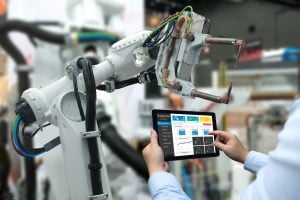Digital Transformation Is The Wave of the Future – Are You Ready?
The manufacturing industry is becoming increasingly focused on digitalization with many companies already looking ahead and adopting new technologies. In fact, IDC predicts that organizations worldwide will invest $5.9 trillion in digital transformation between 2018-2021*.
Now, more than ever, manufacturing executives and decision makers are looking to leverage digital transformation in smart manufacturing to cut costs, drive efficiencies and meet ever-changing customer demands, and many have already started their journey.
But what is digital transformation and how does it impact manufacturing?
Digital transformation in the manufacturing industry
In manufacturing, digital transformation involves a wide range of technologies such as connected machines and services, networked sensors, data analytics, Artificial Intelligence (AI) and Machine Learning. The goal of digital transformation is to improve processes and enable manufacturers to create a sustainable, competitive advantage.
Like all organizational change, successful digital transformation is driven by sound leadership, planning and knowledge. Identifying the right level of digitalization for your organization is vital, so working with a trusted partner at the very start of your journey is critical.
Let’s explore the benefits of digital transformation.
Predictive maintenance: a key benefit of digital transformation
One of the key benefits of smart manufacturing is the ability to reduce machine downtime with predictive maintenance. When issues such as unusual temperature change, vibration or machine slowdown start to occur, data can alert operators so any problem can be addressed and fixed before the situation escalates.
In an automated factory, some maintenance issues can be solved and corrected without the need for human intervention by using a variety of AI-based technologies. Alternatively, machines can act as a co-pilot, alerting factory managers, engineers and operators to potential problems, so they can decide what action to take and address issues before the machine breaks.
Reducing quality and waste issues with smart manufacturing
Many manufacturers have experienced the negative impact of quality issues. Estimates find that the cost of poor quality is typically between 10% and 20% for most manufacturing companies, but can be as high as 30%.
Digital transformation technologies enable manufacturers to reduce issues around poor quality, ultimately saving money on costs associated with repair, rework, scrap, service calls, and warranty claims.
It’s also important to acknowledge that poor quality can also lead to issues around public health and safety, regulation breaches and other serious risks. In this context, improving quality with digital transformation could be viewed as a risk management activity as well as an area of cost reduction.
A dynamic working environment for a dynamic workforce
A smart factory is a forward-thinking, dynamic work environment and manufacturers that adopt new technologies are extremely well-positioned to engage and retain a strong workforce.
In a connected factory, individuals can access the same information wherever they are in the network by working from one single source of truth instead of a collection of separate databases. This fosters a culture of collaboration and enables people to innovate and problem solve together, rather than working in separate silos.
Because of digital transformation, smart factories can future proof themselves from issues relating to manual labor shortages.
Seeing digital transformation in action
So, how are some businesses currently implementing digital transformation in their factories? One of our customers is a global pharmaceutical and consumer packaged goods company that has engaged in a long-term digital transformation journey aiming to deliver increased personalization, improve access and affordability of products, achieve more agile, responsive and flexible manufacturing, and operate more sustainably and profitably.
At the outset, the business turned to academics, technology providers and other experts for advice that would inform its strategy. They presented the business case and transformation plan to leadership to get financial and cultural support before a rigorous Test & Learn phase, starting small and scaling up.
Internal and external collaboration was key to helping the company transform digitally and it is now operating more efficiently and sustainably, gaining a competitive edge.
Getting started on your digital transformation journey
Digital transformation is an organization-wide process. It’s a journey that requires buy-in from all levels, an understanding of your business objectives, and the right Industry 4.0 technology partners to help you achieve your goals. The sooner your organization gets started, the sooner it can start gaining insights and become more competitive and, ultimately, more profitable.
*IDC FutureScape: Worldwide Digital Transformation 2019 Predictions (Oct 2018)
Ready to start your digital transformation journey?
Download our comprehensive Digital Transformation Manual: The Practical Path to Smart Manufacturing.
In this guide, we offer practical recommendations on how to benchmark your organization on the digital transformation curve and what steps to take to kickstart your journey and progress.


